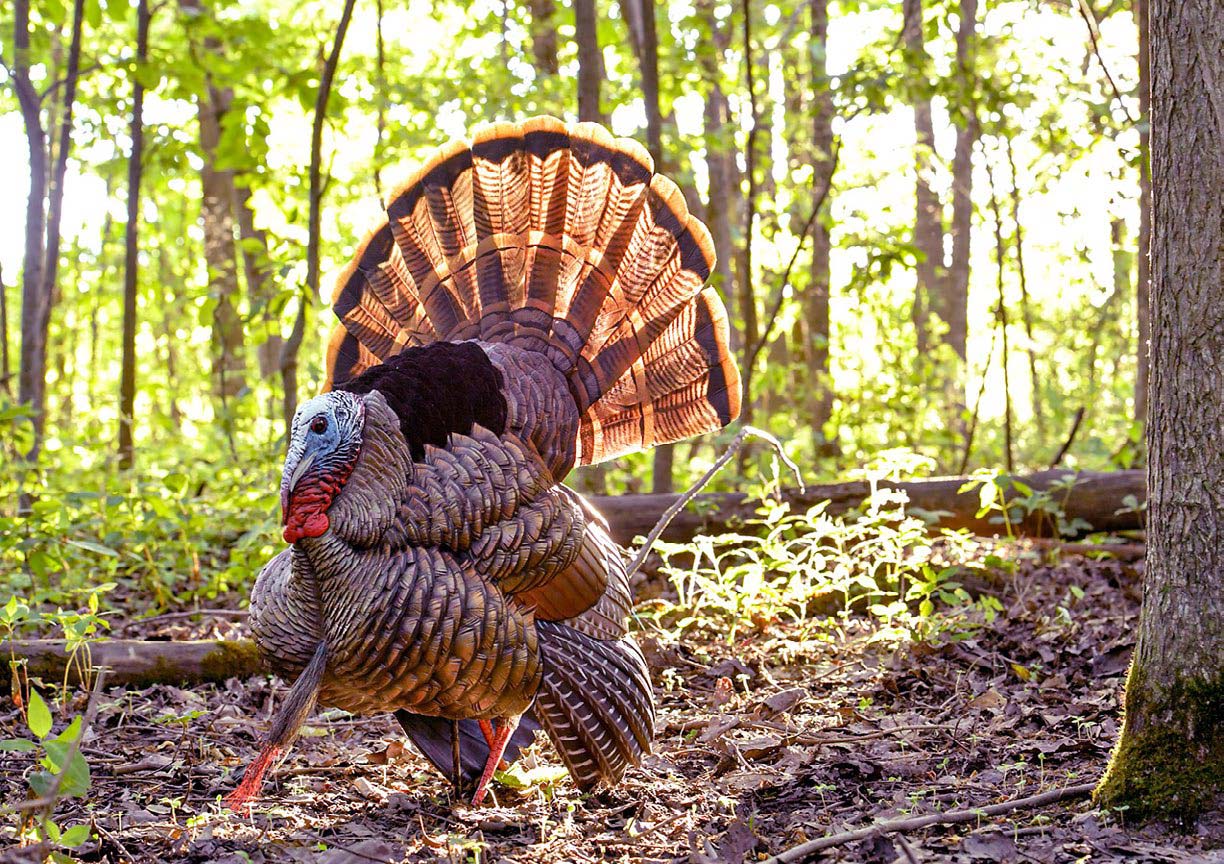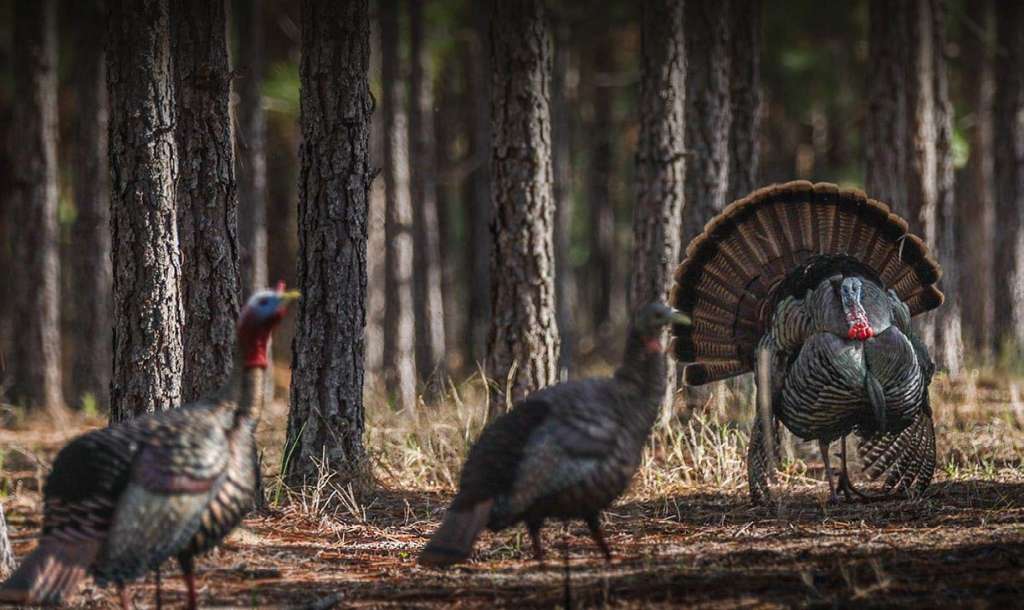It’s 6:30 in the morning. The sun is just coming up over the ridge and casting its first light over my turkey decoys. I have been listening to toms gobble all around me for the last 40 minutes now.
I drag my striker over the glass on my pot call and let out a few yelps. There’s a gobbler roosted in a tree about 20 yards behind me as he lets out a few gobbles. I let out a few more light yelps myself, and he can’t resist; he’s committed. He pitches down and starts to strut about 20 yards from my turkey decoys. He charges my jake decoy looking for a fight, and I draw back my bow. As soon as he stops, I apply pressure to my release until an arrow flies. I watch my arrow disappear into the big tom.
There are few things as exciting as a cool, crisp morning in the turkey woods set up over a decoy set. Let’s talk about a few turkey decoy tactics that can help bring in a tom for a successful turkey hunt.

Hen Decoys
If I could only take one decoy to the woods with me, it would definitely be an Avian-X HDR hen decoy. They are the most versatile decoys to use in the turkey woods.
Why? First and foremost, during the spring turkey season, a big gobbler has one thing on his mind: breeding. Love is in the air and all he is looking for is a hen that is willing to breed. This is the first reason these are the best turkey decoy. A hen alone in an open area that a gobbler can see in the distance, combined with a few yelps, is all that may be needed to bag a nice tom.
Now, a tom may not come charging into the decoys like some of the other setups we will discuss, but the goal is to kill a turkey, and a lone hen will do the trick. Another reason this setup can work better than others is that toms are establishing the pecking order for breeding. The way they do this is by fighting each other. If you have a shy tom that has lost a few fights, he may be scared off by anything other than a lone hen decoy. He still has breeding on his mind but may be afraid of the fight. There are several positions for you to place a decoy; I recommend anything other than putting it in a laying-down position. I will explain more about this when we get to jake decoys. But, if I can only get one decoy, I would spend my money on a good hen decoy.

Jake Decoys
A jake is an immature tom, one that is usually only a year old. They still have the urge to breed but they are far from the king of the spring in that area. They are easy to identify with their short little beards and shorter spurs. Don’t let that fool you though—jakes will still fight.
One of my favorite decoy setups in the spring is placing my Avian-X HDR jake decoy with a lone hen— and using only those two decoys. In that case, you want to place the jake facing away from the direction you expect toms will come. One thing about the Avian-X jake decoy is that it has two different heads, providing for both aggressive and submissive postures. I use the submissive head for this setup. I usually put them about 15 yards in front of me in a fairly open area. Remember that toms will hang up and strut about 20 yards from your decoys, so take this into consideration to be able to get a shot.
Placement
It is key to keep your turkey decoys in an open area. Turkeys have great vision and can see a long way away. This is why decoys can be so effective. If there is a boss tom in the area looking for hens to breed, the fight is on when he sees a jake with a lone hen. This is one of those setups where the tom will charge into the decoys looking to fight the jake and chase him off.
These are the hunts you won’t forget. I like to let out a few yelps every 15 minutes or so unless I have a gobbler responding. If he is responding to my calls, I will call back to keep his attention. It is important to stay motionless if a tom comes in close. In a situation like this, I like to use my Woodhaven mouth calls. This allows me to keep my bow at the ready. Once a tom comes in, I don’t like to give him enough time to figure out that the decoys are fake, so I take the first shot I get.
If you find that a feeding hen decoy isn’t working, try a hen decoy in a laying-down posture, which is the breeding position for hens. Provided that the tom wouldn’t come in before, you can try this as an alternate setup, since this will surely get his attention. A tom is not going to let a jake breed before he does, especially if he is a boss tom. This is partly why I said this is one of my favorite decoy sets to use, especially early in the turkey season before the toms have been involved in a lot of fights.

Tom Decoys
About the only time I use a full-strut tom decoy is early in the season. I will place this decoy about 10 to 15 yards from where I am set up, then face the decoy in the direction where I anticipate the toms will come from. I like to place three or four hens out there with him.
This is the time of the season when toms are establishing the pecking order and the boss tom in the area will surely move in for a fight. This situation can result in some very exciting times in the turkey woods, so just be ready for it to happen. After the pecking order has been established, most toms will shy away from a full-strut tom, especially if he has been on the losing end of a few fights.
The other time I will use a full-strut decoy is placing it over a lay-down hen. I will only do this if I know one of the most mature toms in the area is close by. A tom like that will definitely come into this decoy setup; while most other toms will shy away from it. Like all decoy tactics, it is important to know what’s going on with the local flock to keep things as realistic as possible. When it comes to realism my go-to full-strut decoy is Avian-X HDR strutter. I have yet to find a better-looking or more lifelike full-strut decoy than this.
The Must-Haves
Along with great turkey decoys and some solid tactics, there are a few other things I wouldn’t want to leave the house without for a turkey hunt.
The first is some great camo. When it comes to camo Blockers Outdoors, the new Finisher Series in bottomland is a must. Everything about this series was designed for the turkey hunter, right down to the awesome logo.
The next thing is good calls. There are two companies I trust in the turkey woods: ESH Custom Calls and Woodhaven. (I have written a few articles on basic calling techniques if you need to freshen up on that topic)
Another item I suggest taking along is a comfortable chair. You could sit on the ground, but the BOG-hunting product Snood Seat is comfortable and perfect for waiting out a gobbler.
My last suggestion is to have a good ground blind if you can’t blend into the natural surroundings. My go-to blind is BOG’s Grave Digger. It is big enough for two people and keeps your movement concealed. Remember, turkeys have great vision, so hunting from a blind lets you get away with more movement, especially in bow hunting. I also recommend a blind for times when you take kids turkey hunting. My daughter loves to tag along, and with that, I don’t have to worry about her spooking any toms.

In Closing
Turkey decoys can be highly effective throughout all of turkey season. It’s important to scout your hunting area out and know what the turkeys are doing in your local area so that your decoy spread is realistic. I like to place my Stealth Cam reactors on field edges on video mode. This not only allows me to know what’s going on, but I also get some awesome videos.
Don’t forget too, that if one decoy spread is not working, try another. When starting out, if you can only get one decoy, I would get a good hen decoy. Remember that hens are what the toms are searching to find. It’s also important to practice your calling. That’s a way to further up your odds of bagging a big old tom. And if nothing else, make sure you get out in the woods this spring and enjoy the hunt.
Read More: A Recipe for Turkey Enchiladas Colorado
Per our affiliate disclosure, we may earn revenue from the products available on this page. To learn more about how we test gear, click here.







